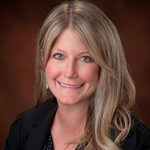By Casey L. Hogan, OD, FAAO, FSLS

June 23, 2021
Specialty contact lenses give you a chance to change patient lives while spurring significant profitability. Here is how my practice is continuing to develop a specialty contact lens niche that is delivering robust growth and revenue generation.
Specialty contact lenses are traditionally defined as contact lenses that are designed for patients with corneal pathology who could not obtain functional vision and comfort with conventional soft contact lenses. In our practice, specialty contact lenses include rigid gas permeable lenses such as sclerals, small diameter lenses and intralimbal lenses. In addition, we fit hybrids, or soft lenses, that are not only employed for the treatment of corneal disease, but also for myopia control, high refractive error or presbyopic correction and ocular disease conditions. Our regular cornea patients, who have high expectations for improved quality of vision, are excellent candidates for specialty lenses.
Primed for Growth
We began developing our specialty lens niche in 2007, investing in technology, training and marketing. Over the years we have grown our specialty lens practice. We are at about 60 percent specialty lens patients and 40 percent conventional lens patients. Ninety percent of my specialty lens patients are in sclerals or small diameter gas permeable lenses.
We recently added a second specialty lens fitter to our practice, Tiffany Polanek, OD, who, like me, taught at Illinois College of Optometry in the Cornea Center for Clinical Excellence. Since the addition of Dr. Polanek, we have seen approximately 5 percent year-over-year growth in the specialty lens area of our practice.
Impressive Potential for Profitability
Profitability is not only greater for the lens product, but also for the diagnostic fitting and professional services. This can not be stressed enough–a practitioner should not undervalue their expertise, and most patients who are seeking care and consultation from an “expert specialty lens fitter,” expect to pay higher fees for service.
In our practice, the specialty lens professional fees are on average seven times greater than traditional lens fitting fees. Our support staff educates patients on the why behind higher fee structures and well-defined cornea/contact lens service agreements. Generally, the cost of goods is higher for specialty lens products, and a practitioner should charge accordingly. We always feel that we do not want to be the “lowest-priced practice on the block.”
Become a Specialty Lens Expert
The first step in establishing the growth of your specialty lens practice is to do the work to become an expert. You must educate yourself and not only know the theory behind the lenses you are fitting, but also completely understand the pathophysiology and condition you are managing with specialty lenses.
Managing lens complications is key, and this comes with experience and knowledge that you don’t gain from a one-hour webinar. You must invest in your self-education. The true expert understands this concept and the educational journey it takes to minimize complications and modifications. Modifications are costly and can eat at your bottom line. Happy patients who are well fit and educated will refer patients, and this word-of-mouth marketing is ideal for growing your practice.
In building a scleral lens specialty practice, consider mastering the fitting of one brand to get started, such as Blanchard Contact Lenses, a CooperVision Specialty Eye Care company. Onefit MED and Onefit MED+ – are fully customizable scleral lens designs for highly irregular/medically indicated corneas, as well as normal corneas, when a larger diameter is needed.
Invest in Instrumentation
Key specialty contact lens investments in basic technology include a topographer and a good anterior segment camera, and the traditional instrumentation including a slit lamp, fitting kits and vital dyes. Meibography, pachymetry and anterior segment OCT are a wise second investment arm as you continue to grow your anterior segment/specialty lens practice. The third arm of investment would be a scleral lens topographer and a specular microscope.
Other Articles to Explore
Manage Patient Flow & Your Time
In our practice, conventional lens evaluations are booked in 20-minute intervals; we schedule 40 minutes for every specialty lens consultation, 40 minutes for the actual fitting and 20 minutes for all follow-up visits. We designate one day per week for new consultations, and two 40-minute blocks at the beginning of every day, prior to lunch, and after our lunch. Specialty lens patients are flexible, as they want to be properly evaluated and are motivated for care that will improve their quality of life. If these slots are not filled, staff are trained to fill from our cancellation list for routine examinations.
Train Support Staff
New support are trained on what specialty lenses are. They learn everything from how to pronounce “scleral lenses” to what these lenses are and the conditions they are prescribed for. All staff, from the front office to the medical assistants, are trained in this way. The majority of equipment and lens companies are more than happy to schedule training in office with your staff. It is equally important to appoint a specific staff member to review professional fees and contracts with patients, training staff how to use Google Sheets for tracking insurance filings, payments, lens orders, warranties and modifications. The use of team spreadsheets like Google Sheets is important as you grow your practice.
Market Your Services
In our early years of establishing this niche, we filed a State of Illinois DBA (doing business as) license to carve out our specialty lens practice. This may vary by state, but in Illinois, where we practice, this allowed our specialty lens DBA to exist under our established S-corporation for legal and tax filings, but afforded a unique marketing strategy for targeting new patients externally and generated new referrals from outside providers.
We also educated all of our co-managing surgeons on our specialty lens services, not only for corneal disease, but for all forms of ocular surface disease including dry eye management. We invited surgeons to join us for a day to evaluate their own patients whom we have successfully fit. We held in-office fitting seminars with local optometrists, and educated our local peers who did not want to invest in this technology or have a clinical environment that would allow for this technology. We always remember the importance of referring patients back to the referring optometrist for all primary eyecare needs. As marketing strategies always evolve over time, it is wise to revisit your marketing plan every year.
With the right approach to caring for specialty contact lens patients, and communicating your services to other healthcare practitioners and your community, specialty contact lenses can become an engine for practice growth.
 Casey L. Hogan, OD, FAAO, FSLS, is the owner of the Advanced Eye Care Professionals, PC, and The Chicago Dry Eye Center of Excellence. To contact her: chogan6465@aol.com
Casey L. Hogan, OD, FAAO, FSLS, is the owner of the Advanced Eye Care Professionals, PC, and The Chicago Dry Eye Center of Excellence. To contact her: chogan6465@aol.com

























